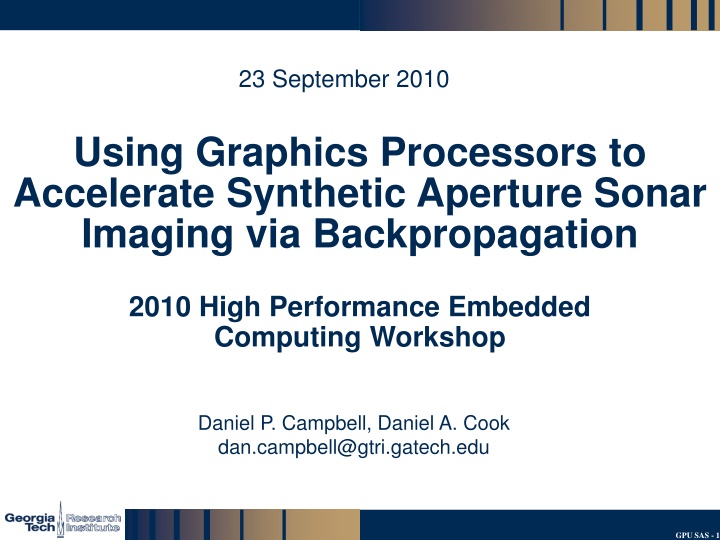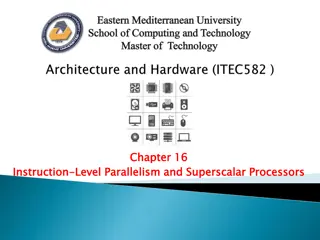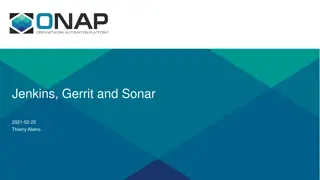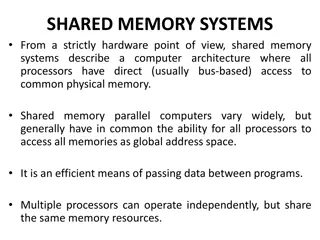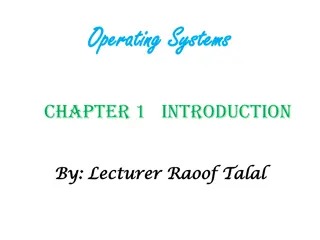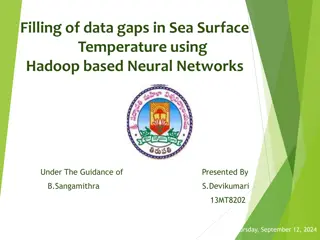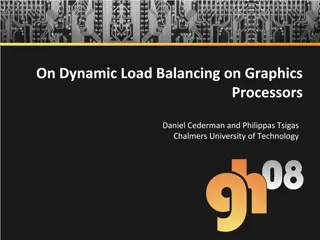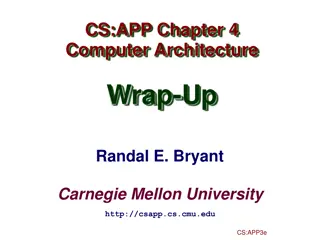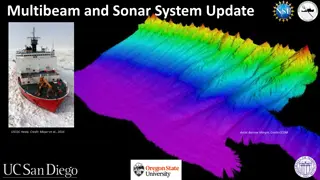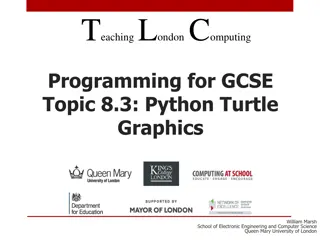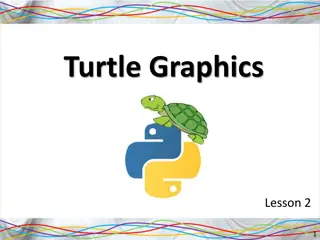Leveraging Graphics Processors for Accelerating Sonar Imaging via Backpropagation
Utilizing graphics processors to enhance synthetic aperture sonar imaging through backpropagation is a key focus in high-performance embedded computing workshops. The backpropagation process involves transmitting sonar pulses, capturing returns, and reconstructing images based on recorded samples. This approach offers practical benefits, such as algorithmic simplicity, ease of coding, and flexibility in adverse conditions compared to traditional methods. The equivalence between sonar and radar technologies further enables the use of the same code for both applications, with SAR processing benefiting from the assumed stationary platform during pulse transmission.
Download Presentation

Please find below an Image/Link to download the presentation.
The content on the website is provided AS IS for your information and personal use only. It may not be sold, licensed, or shared on other websites without obtaining consent from the author.If you encounter any issues during the download, it is possible that the publisher has removed the file from their server.
You are allowed to download the files provided on this website for personal or commercial use, subject to the condition that they are used lawfully. All files are the property of their respective owners.
The content on the website is provided AS IS for your information and personal use only. It may not be sold, licensed, or shared on other websites without obtaining consent from the author.
E N D
Presentation Transcript
23 September 2010 Using Graphics Processors to Accelerate Synthetic Aperture Sonar Imaging via Backpropagation 2010 High Performance Embedded Computing Workshop ECRB - HPC - 1 Daniel P. Campbell, Daniel A. Cook dan.campbell@gtri.gatech.edu GTRI_B- # GPU SAS - 1
Sonar Imaging via Backpropagation Forward Travel ECRB - HPC - 2 As the sonar passes by the scene, it transmits pulses and records returns. Each output pixel is computed by returns from the pulses for which it is within the beamwidth (shown in red). A typical integration path is shown in yellow. GTRI_B- # GPU SAS - 2
Backpropagation Backpropagation is the simplest synthetic aperture image reconstruction algorithm for each output pixel: Find all pulses containing reflections from that location on the ground Find recorded samples at each round-trip range Inner product with expected reflection Sum all of these data points end ECRB - HPC - 3 GTRI_B- # GPU SAS - 3
Backpropagation Practical Advantages Procedure Attempt to fly a perfectly straight line Compensate for unwanted motion Form image using Fourier-based method backpropagation Register and interpolate image onto map coordinates Algorithmic simplicity Easier to code and troubleshoot Less accumulated numerical error Flexibility Can image directly onto map coordinates without the need for postprocessing (including bathymetric maps) Expanded operating envelope Can form imagery in adverse environmental conditions and during maneuvers ECRB - HPC - 4 GTRI_B- # GPU SAS - 4
Sonar vs. Radar Typical SAS range/resolution: 100m/3cm Typical SAR range/resolution: 10km/0.3m SAS and SAR are mathematically equivalent, allowing the same code to be used for both The sensor is in continual motion, so it moves while the signal travels to and from the ground Light travels 200,000 times faster than sound, so SAR processing can be accelerated by assuming the platform is effectively stationary for each pulse. ECRB - HPC - 5 GTRI_B- # GPU SAS - 5
Sonar vs. Radar ECRB - HPC - 6 In general, the sensor is at a different position by the time the signal is received (above). If the propagation is very fast (i.e., speed of light), then the platform can be considered motionless between transmit and receive (below). GTRI_B- # GPU SAS - 6
Advantages of Backpropagation FFT-based reconstruction techniques exist Require either linear or circular collections Only modest deviations can be compensated Requires extra steps to get georeferenced imagery Backpropagation is far more expensive, but is the most accurate approach No constraints on collection geometry: can image during maneuvers Directly produces imagery located on any map coordinates desired ECRB - HPC - 7 GTRI_B- # GPU SAS - 7
Minimum FLOPs Range out Estimated r/t time Beam Check Final receiver position Final platform orientation Construct platform final R Apply R Add platform motion Range In Range->Bin Sample & Interpolate Correlate with ideal reflector Accumulate Total 65 9 1 5 Not needed for Radar 6 35 15 9 111 9 2 9 9 2 ECRB - HPC - 8 GTRI_B- # GPU SAS - 8
GPU Backpropagation GTRI SAR/S Toolbox, MATLAB Based Multiple image formations Backpropagation too slow GPU Accelerated plug-in to MATLAB toolbox CUDA/C++ One output pixel per thread Stream groups of pulses to GPU memory Kernel invocation per pulse group ECRB - HPC - 9 GTRI_B- # GPU SAS - 9
Direct Optimization Considerations Textures for clamped, interpolated sampling 2-D blocks for range (thus cache) coherency Careful control of register spills Shared memory for (some) local variables Reduced precision transcendentals Recalculate versus lookup Limit index arithmetic ECRB - HPC - 10 GTRI_B- # GPU SAS - 10
GPU Ocelot Courtesy, Computer Architecture and Systems Laboratory, Georgia Tech http://www.ece.gatech.edu/research/labs/casl/index.html ECRB - HPC - 11 G. Diamos, A. Kerr, S. Yalamanchili, and N. Clark, Ocelot: A Dynamic Optimizing Compiler for Bulk Synchronous Applications in Heterogeneous Systems, IEEE/ACM International Conference on Parallel Architectures and Compilation Techniques, September 2010. GTRI_B- # GPU SAS - 11
Productivity Tools for Hybrid Systems Debugging Memory race detection Bounds checks Ocelot Dynamic Execution Infrastructure Profiling/Performance Tuning Alignment behavior Control flow behavior Inter-thread data flow ECRB - HPC - 12 Integration with Front-End profiling tools GLIMPSES (S. Pande) GTRI_B- # GPU SAS - 12
Ocelot data ECRB - HPC - 13 GTRI_B- # GPU SAS - 13
Ocelot Findings 82.25 FLOPS per pixel*pulse, too high a = calc1(); b = calc2(); if (a<constant) { 25% Speedup ECRB - HPC - 14 Did not expect any! tyx = ThreadIdx.x * BLOCK + ThreadIdx.y; share[tyx] = foo; 5% Speedup GTRI_B- # GPU SAS - 14
Performance versus Image Size Critically sampled - GTX480 4.5E+9 16 4.0E+9 14 3.5E+9 12 3.0E+9 10 Run time(s) 2.5E+9 pp/s 8 2.0E+9 6 1.5E+9 4 1.0E+9 ECRB - HPC - 15 2 5.0E+8 0.0E+0 0 512 1024 1536 2048 Image Size (edge pixels) 2560 3072 3584 3936 pp/s Run time (s) GTRI_B- # GPU SAS - 15
Strong Scaling Results Performance with 1-8 GPUs, single node 3936 x 3936 image, 3936 input pulses, 1-8 Tesla C1060 12.0E+9 40 35 10.0E+9 30 8.0E+9 25 Run time (s) PP/s 6.0E+9 20 15 4.0E+9 10 2.0E+9 ECRB - HPC - 16 5 000.0E+0 0 1 2 3 4 5 6 7 8 GPUs pp/s pp/s/g Run time GTRI_B- # GPU SAS - 16
Performance Alternate Configurations Configuration Run time (s) pp/s FLOPS/pp FLOPS/s SAS 14.78 4.13E+9 Stop & Hop 12.82 4.76E+9 Ignore Beam 111 22.81 2.67E+9 296.73E+9 SAR (S&H+IB) 32 16.52 3.69E+9 118.12E+9 3936 x 3936 Image from 3936 pulses Alternate configurations not optimized GTX 480 ECRB - HPC - 17 GTRI_B- # GPU SAS - 17
Future Work Further optimization Reoptimize for Fermi Tune for multi-GPU Multi-node Improve error handling, edge cases, etc. Backpropagation server ECRB - HPC - 18 GTRI_B- # GPU SAS - 18
